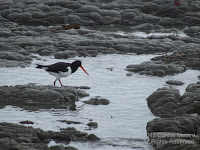AMERICAN OYSTERCATCHER
AMERICAN OYSTERCATCHER (Haematopus palliatus) – (see images below)
DESCRIPTION: The American oystercatcher is a shorebird with a black head and breast, dark grey back, wings and tail, and white under parts. The bright orange and sturdy bill is almost twice as long as the head. The legs are pink, and the yellow eyes have an orange eye ring. Sexes are similar. This bird is about 42 cm (16 inches) long.
VOICE: https://www.xeno-canto.org/
NAME: The English name is very straightforward – ‘Oystercatcher’ means just that. The Latin genus name ‘Haematopus’ means ‘blood-red foot’, and the Latin species name ‘palliatus’ means ‘wearing a cloak’, in reference to the back black plumage.
HABITAT: Coastal beaches (sandy or rocky), mudflats.
DIET: Oysters and other hard-shelled molluscs.
NESTING: The nest is a scrape in the sand and lined with either sand or pebbles. About three grey-beige eggs are laid, incubated by both parents. They also both care for the chicks. This bird breeds near the tide line, which at times can negatively impact the brood.
DISTRIBUTION: Year-round resident along the Atlantic coast of the USA from around New Jersey and south, the western coast of Mexico, and both coasts of South America. Breeding range along the Atlantic coast from New Jersey up to New England. Wintering population in Florida and the Caribbean.
DISTRIBUTION MAP: https://en.wikipedia.org/wiki/American_oystercatcher#/media/File:Haematopus_palliatus_map.svg
ON PEI: The American oystercatcher does not breed on Prince Edward Island, and there have only been accidental sightings so far of this bird on the island.
CONSERVATION: This species is widespread and its population is stable enough that it is not currently considered at risk.
NOTES: Oystercatchers have a highly specialized bill to pry open oysters (as the name implies). One technique used to get the shellfish is by scouting shellfish beds at low tide and looking for half-open ones. Then the bird will dart its bill to cut off the muscle inside that attaches the animal to its shell. However, if they’re not quick enough and if the mollusc is still anchored to the rock in the water, for example, then the mollusc may have time to clamp down on the bird’s bill and the bird may get stuck there and drown when the tide is rising.SIMILAR SPECIES: The SOUTH ISLAND OYSTERCATCHER (Haematopus finschi) is very similar to the American oystercatcher (see photos below), but is endemic to New Zealand.
The EURASIAN OYSTERCATCHER (Haematopus ostralegus) is also very similar to the American oystercatcher (see photos below), but its range covers Europe including Iceland, and parts of Asia.
REFERENCES: https://en.wikipedia.org/wiki/American_oystercatcher
https://www.allaboutbirds.org/guide/American_Oystercatcher/lifehistory
https://www.audubon.org/field-guide/bird/american-oystercatcher
American Bird Conservancy (American Oystercatcher)
http://www.nhptv.org/natureworks/americanoystercatcher.htm (New Hampshire PBS)
https://identify.whatbird.com/obj/1013/overview/American_Oystercatcher.aspx
DESCRIPTION: The American oystercatcher is a shorebird with a black head and breast, dark grey back, wings and tail, and white under parts. The bright orange and sturdy bill is almost twice as long as the head. The legs are pink, and the yellow eyes have an orange eye ring. Sexes are similar. This bird is about 42 cm (16 inches) long.
VOICE: https://www.xeno-canto.org/
NAME: The English name is very straightforward – ‘Oystercatcher’ means just that. The Latin genus name ‘Haematopus’ means ‘blood-red foot’, and the Latin species name ‘palliatus’ means ‘wearing a cloak’, in reference to the back black plumage.
HABITAT: Coastal beaches (sandy or rocky), mudflats.
DIET: Oysters and other hard-shelled molluscs.
NESTING: The nest is a scrape in the sand and lined with either sand or pebbles. About three grey-beige eggs are laid, incubated by both parents. They also both care for the chicks. This bird breeds near the tide line, which at times can negatively impact the brood.
DISTRIBUTION: Year-round resident along the Atlantic coast of the USA from around New Jersey and south, the western coast of Mexico, and both coasts of South America. Breeding range along the Atlantic coast from New Jersey up to New England. Wintering population in Florida and the Caribbean.
DISTRIBUTION MAP: https://en.wikipedia.org/wiki/American_oystercatcher#/media/File:Haematopus_palliatus_map.svg
ON PEI: The American oystercatcher does not breed on Prince Edward Island, and there have only been accidental sightings so far of this bird on the island.
CONSERVATION: This species is widespread and its population is stable enough that it is not currently considered at risk.
NOTES: Oystercatchers have a highly specialized bill to pry open oysters (as the name implies). One technique used to get the shellfish is by scouting shellfish beds at low tide and looking for half-open ones. Then the bird will dart its bill to cut off the muscle inside that attaches the animal to its shell. However, if they’re not quick enough and if the mollusc is still anchored to the rock in the water, for example, then the mollusc may have time to clamp down on the bird’s bill and the bird may get stuck there and drown when the tide is rising.SIMILAR SPECIES: The SOUTH ISLAND OYSTERCATCHER (Haematopus finschi) is very similar to the American oystercatcher (see photos below), but is endemic to New Zealand.
The EURASIAN OYSTERCATCHER (Haematopus ostralegus) is also very similar to the American oystercatcher (see photos below), but its range covers Europe including Iceland, and parts of Asia.
REFERENCES: https://en.wikipedia.org/wiki/American_oystercatcher
https://www.allaboutbirds.org/guide/American_Oystercatcher/lifehistory
https://www.audubon.org/field-guide/bird/american-oystercatcher
American Bird Conservancy (American Oystercatcher)
http://www.nhptv.org/natureworks/americanoystercatcher.htm (New Hampshire PBS)
https://identify.whatbird.com/obj/1013/overview/American_Oystercatcher.aspx
 |
| American oystercatcher, FL by Roberta Palmer |
 |
| American oystercatcher, Dick Daniels |
 |
| South Island oystercatcher, New Zealand |
 |
| South Island oystercatcher, New Zealand |
 |
| Eurasian oystercatcher, Iceland, by Roberta Palmer |
 |
| Eurasian oystercatchers on rooftop Iceland, by Roberta Palmer |